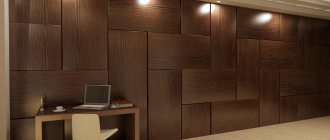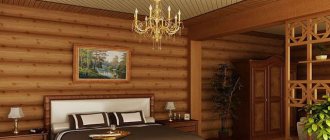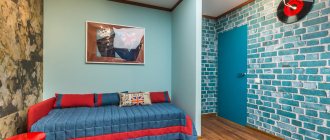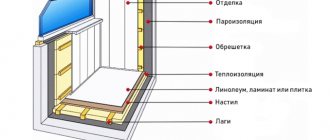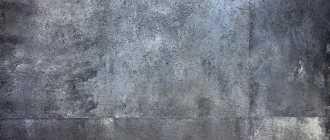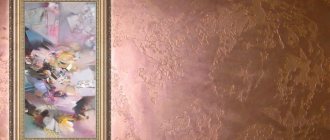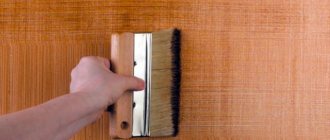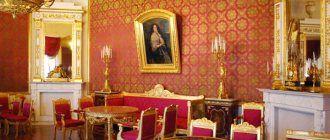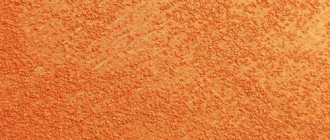Decorative wall decoration, that is, interior finishing work, is the most “delicious” creative part of the renovation. A variety of ideas for decorating walls, decorating the comfort of your own home or office are achievable today more than ever! The market offers a myriad of finishing materials for indoor walls. There has long been a succinct saying that even the walls of a home can heal—it’s not for nothing that people say that. To ensure that a large selection does not lead to some confusion, it is enough to have a clear idea of what you want, as well as a little understanding of what modern finishing materials are.
A lovingly thought out, harmonious interior truly relieves stress and calms you down.
Decorating walls with various materials, which has become so organically relevant and so beloved, has a number of advantages:
- such design is almost always unique, inimitable;
- adaptable to absolutely any stylistic decision - from classic to the most daring;
- perfectly camouflages light unevenness and surface defects;
- significantly increases sound insulation;
- significantly enhances the moisture resistance of surfaces.
Paint for interior wall decoration
Painting is the most common, main available method of decorating walls. It is based on the application of coloring materials (paints) to the surface. A huge selection of colors, the presence of various techniques (which can be used even without special training) make it especially popular. For interior coatings, mainly two main types of paint are used: either acrylic or alkyd.
Acrylic paints include water-based and water-based dispersion paints. Advantages: this dye is affordable, easy to work with (due to its composition, practically odorless), it is suitable for decorating absolutely any room. Most often, acrylic paints are used to cover large surfaces; they dry very quickly.
Decorative wall decoration, photo:
Alkyd paint is used a little less frequently; it is dissolved with white spirit or turpentine.
Advantages: indispensable for working on large, small wooden or metal elements - window, door frames, pipes, heating radiators. By combining different gradations, tones of the same color, related or contrasting colors in one room, you can easily create a unique, unusual, but cozy space.
Texture for walls of lime-sand plasters
Depending on the type of filler, decorative plaster comes in the following types:
- structural;
- textured;
- Venetian
The first two form a rough surface; such plaster is also called embossed. Structural has a thinner layer structure than textured, and is made on an acrylic or silicate base. Venetian plaster (see the basics of finishing it) gives a perfectly smooth surface - a decorative multi-layer coating. It is made with the addition of marble chips, which gives it a certain texture or pattern (the surface is even). It can also imitate precious metals when special pigments are added to it. It is a fairly expensive material and requires skill in application.
All these types of plasters are environmentally friendly, safe, and durable.
Decorative plasters are also divided according to the type of binder in them:
- Acrylic – due to acrylic resin, good elasticity is obtained. The purchased mixture is already ready for use. Among the disadvantages is low vapor permeability, which imposes restrictions on the scope of its application. Also afraid of UV rays.
- Silicone - based on synthetic resins. It has good ductility and is suitable for interior and exterior decoration. Resistant to UV rays, does not attract dust. Due to its water-repellent properties, it can be used in rooms with high humidity.
- Mineral (cement) - based on cement as a binder. This is the most commonly used version of plaster for walls. It has a low price, and at the same time good performance - sufficient strength, resistance to UV rays, and environmental friendliness. Sold as a dry mixture that must be diluted with water before use.
- Silicate - liquid glass is used as a binder (essentially quartz glue). This plaster is well used for exterior finishing and in conditions of high humidity and aggressive environmental influences. The applied layer has high strength, resistance to water (creates a water-repellent layer, and at the same time has vapor permeability), rotting, and mold. This plaster is fireproof. Of all types, it is the most reliable and durable; its service life can reach 50 years or more.
Decorative plaster for interior wall decoration
Another undisputed leader in the construction market used for interior work is decorative plaster. This is an excellent finishing material for walls inside the apartment.
No wonder, because the advantages of this material are obvious:
- protection from mechanical damage;
- individual design of rooms is achieved with a minimum of effort;
- the composition includes environmentally friendly natural materials;
- the condition remains good for a long time, keeps its shape perfectly;
- washes and cleans well.
In appearance, decorative plaster is a special heterogeneous mixture of different structures and grain sizes. For interior work, compositions that dissolve with water are ideal (they do not have a strong odor).
In the photo the walls are decorated with decorative plaster:
As a rule, plasters can be tinted, that is, several shades of pigments can be mixed in order to achieve an individual exact tone, to fully realize the plan. There are a lot of techniques for applying plaster, all of them are quite simple to perform.
Decorating with plasterboard
Plasterboard walls
Plasterboard is a modern finishing material that is widely used in any apartment, even in a new building, to create frames, shelves, arches and other decorations. Although plasterboard sheets are a budget type of finishing, they are also used by the rich for interior work. Cladding material is also very popular for wall decoration, you need to know its pros and cons:
| Advantages: | Flaws: |
| You can hide communications. | Exposure to moisture, not recommended for use in bathrooms or kitchens. |
| There is no need to level the walls. | Plaster and drywall are fragile and can be damaged. |
| Installation is easy and fast. | The sheathing leaves voids, making the wall echoing. |
| Allows you to decorate the house in different geometric shapes. | |
| It is possible to insulate the walls and ceiling. |
There are different options for finishing walls in an apartment with plasterboard. Some prefer to glue plasterboard material, others use the frame method of cladding, where you can hide insulation in the form of foam plastic or mineral wool. Insulation allows you to get not only warmth in winter, but also sound insulation.
After installation, you need to putty over the entire drywall, paint it, sculpt it, or cover it with other decorative materials. Some people cut out shapes and glue them for decoration.
Ideas for decorating the walls of a room (video)
Wall decoration with wallpaper
Classic wallpapering, it seems, will never cease to be relevant, simple, and affordable.
Currently, the choice of high-quality, sophisticated wallpaper is very wide. The most common:
- paper classic;
- washable vinyl;
- non-woven;
- natural;
- represented by liquid textures.
Ordinary paper wallpapers can be background or embossed, single-layer or double-layer. Considering their environmental friendliness, they are simply irreplaceable for a child’s room or bedroom, they are inexpensive, “breathe”, and easy to glue. The other side of the coin regarding the types of wallpaper finishes: they are short-lived, fade, and get dirty easily.
Non-woven wallpaper is non-woven, high density, applied to paper. They have great strength, but at the same time allow air to pass through. Cracks and surface roughness are camouflaged. They are very easy to stick - the adhesive mass needs to be applied only to a solid base.
Vinyl wallpaper is foamed vinyl applied to a paper or non-woven backing. They can be smooth, embossed, with a pattern, made using hot stamping or silk-screen printing.
They are great for hallways and corridors, as they are moisture resistant, which means they are easy to wash and clean. Such wallpapers retain their color saturation for a very long time, practically do not fade, and are airtight (therefore, it is better not to glue them to the walls of a bedroom or nursery).
Natural wallpapers are made from environmentally adaptive, natural derivatives:
- traffic jams;
- jute;
- straws;
- veneer;
- bamboo;
- reed;
- seaweed
They are applied to a paper or, less commonly, non-woven base. This is an exclusive, very cozy, pleasant to the touch decorative material. To protect against dust, the manufacturer treats such wallpaper with special means. Most often, such natural coatings are used to emphasize individual elements. They are somewhat capricious and require protection from sunlight.
Options for decorative finishing of painted surfaces
Using various decorative finishing options, you can apply various designs to the walls and create on their surface the semblance of full-color three-dimensional images. This type of painting not only saves materials and money, but also provides creative, experimental people with the opportunity to create any designs, ornaments, or paintings on the walls and ceiling of their room (apartment).Spray finish
- the simplest finishing option, the implementation of which is accessible even to beginners. Any finishing is carried out using dried paint. Manual spraying is performed using a hand brush. It is taken in the right hand, soaked in paint, and the excess is squeezed out. They take a stick in their left hand, bring it to the surface at a certain distance and hit it with the brush. In this case, the paint is shaken off the brush and leaves splashes on the surface. The size of the splashes and their outlines depend on how close the stick is held to the surface and how hard you hit it with the brush. With a test spray (on a piece of plywood painted to match the color of the walls), you can determine the required distance and calculate the impact force. If, in addition to the above-mentioned tools and devices, you use meshes with sections of various sizes and shapes for finishing, then you can change the spray pattern. The mesh is strengthened in the frame, pressed against the surface to be finished and sprayed in the same way as described above.
Stencils
. Drawings of any shape and complexity, single or multi-color, can be applied to a pre-painted surface by printing using stencils. Stencils are prepared according to sketches, from thick paper or cardboard, which are oiled several times and dried for strength. The paper is cut into sheets of the required size, a design is applied to them and cut out with a sharp knife. To accurately apply the design, a mark-incision is made on the cut of the stencil, which is aligned with the marking line when moving the stencil. When printing a multi-color pattern, a separate stencil is prepared for each color.
The stencil printing technique is as follows: the stencil is pressed tightly to the surface with the left hand, and the drawing is filled with the right hand using a handbrake of the required size. Dip the brush into the paint and wring it out well so that it is semi-dry. The paint is not smeared, but driven in with gentle blows (so as to avoid splashes), trying to evenly fill the entire space inside the stencil. After printing, the stencil is removed, leaving an exact copy of the image on the surface. When filling with different colors, each subsequent layer is applied with a new brush (or washed cleanly before changing color) over the dried previous one. The stencil is wiped from time to time to remove paint, especially on the side that is applied to the surface of the wall or ceiling. Using a stencil, designs are printed both on the walls and on the ceiling, used for finishing the entire surface or only for friezes, boards, tapestries
Rubber stamps and rollers
. You can apply a design to the surface using rubber stamps and rollers, which are made in factories from soft rubber or molded plastic. This finishing method is more economical and faster than those already described. Strips of rubber with designs cut out on them are attached (glued) to a wooden grater of the same size and shape and a stamp is obtained. It is dipped in color, the excess paint is allowed to drip off, and then applied to the surface, pressed, and the drawing is ready. Rollers can be of two types: with and without a paint reservoir. The roller is secured in a special machine. It uses two rollers in contact with each other: a shaped one made of rubber and a smooth one made of a rubber sponge or foam rubber. A smooth roller is soaked in paint, lightly wrung out and secured in the machine. During operation (knurling), the smooth roller paints the protruding areas of the figured (patterned) roller, which is pressed against the surface and leaves a pattern on it. Periodically, a smooth roller is moistened with paint; it is important to monitor the force of pressure on the roller, since the brightness and saturation of the resulting image depends on this. The force of pressure varies depending on the supply of paint from a smooth roller: the less it is, the harder you should press on the patterned roller. By using a roller with a reservoir, you can speed up the finishing process. The paint from the reservoir is fed directly to the pattern roller through the feed roller, allowing you to paint large surface areas. Before starting work, markings are made on a dry painted surface: depending on the pattern, vertical or horizontal lines are drawn with a chalked cord for the first knurling. Each subsequent strip of the pattern begins to be rolled close to the previous one, making sure that it is vertical. The knurling is done from top to bottom; before “drawing” a new strip, the roller is placed on the surface in the same place so that the pattern does not move. For this purpose, the patterned roller has special marks that are visible to the painter, but are not imprinted on the surface.
The walls are painted with an exquisite roughness, with a frieze in the form of an appliqué of leaves that perfectly sets off the shine of shells, the smoothness of marble and pine wood.
A gold ornament, stenciled onto the walls in a muted gray-green color, ties the “tortoiseshell” mirror frame and elegant objects finished in antique copper and gold into a coherent composition.
Decorative panels for interior wall decoration
Today, the construction market offers a wide range of similar decorative materials for interior wall cladding. The shape and material of manufacture, coupled with convenience and speed of installation, allow you to achieve excellent results quickly and relatively inexpensively. Using panels you can hide imperfections, irregularities, electrical wiring, and other building communications. These decorative materials are attached to a special metal sheathing, which is initially mounted on the mother surface.
Decorative panels are presented as sheets, rectangular canvases, narrow slats. Thus, you can choose an individual, convenient cladding option; they can be installed horizontally or vertically. The most popular, frequently used type of this decorative coating is made from fiberboard, chipboard, MDF, polyvinyl chloride, gypsum, natural (or recycled) wood, and cork. Decorative 3D analogues stand out.
Photos of wall cladding with different materials:
High-quality panels for interior cladding must be environmentally friendly, resistant to moisture and temperature changes. Using different cleaning agents should not be a problem, low flammability in case of fire is also important.
Wall finishing with plasterboard
Drywall is a modern, inexpensive material, a reasonable alternative to plaster when creating a flat surface is required. Even a novice builder can handle drywall; it is non-toxic, non-flammable, and after working with it there is no large amount of dust or construction debris left behind.
The advantages of plasterboard cladding are:
- excellent sound insulation;
- maintaining an acceptable indoor microclimate;
- environmental friendliness;
- the ability to implement any design designs;
- compatibility with other finishing materials that can be used as a topcoat;
- low price.
When working with drywall, you should take into account its fragility; it also needs a reliable frame. If there is an increased level of humidity, then, most likely, it may be necessary to pre-coat the mother surface with a special primer.
Clinker tiles for interior wall decoration
The use of this modern, up-to-date facing material makes it easy to implement the design concept - a high-quality imitation of wood, stone or brickwork. Today, clinker tiles are in demand because, in addition to their high performance qualities, they look very aesthetically pleasing and are not inferior to the natural materials that they imitate.
Clinker imitation stone, photo:
Such tiles are easy to work with, their minimum thickness is only 8 mm, they have a long service life and are resistant to mechanical damage. If you are tiling a kitchen or bathroom, then the level of moisture resistance of this coating must be appropriate.
Clinker tiles have a rich range of colors, and over time the shades do not fade or fade. For cladding, you can choose a material of any texture: smooth, glazed, rough, rustic. Clinker tiles are not affected by mold or various types of fungi, do not emit toxic fumes, are fire resistant, and durable.
Wallpaper
The choice of wallpaper is very large.
- Paper wallpaper.
- Non-woven.
- Vinyl.
- Cork.
- Bamboo.
- Liquid.
- Photo wallpaper.
- You should choose wallpaper based on the nature of the room. For example, in the kitchen, you should give preference to washable wallpaper, especially since it will go better with the tiles. Such wallpaper is also suitable for the corridor, because pollution there is much more common than in the living room.
- To use wallpaper in the bathroom, you need to choose among moisture-resistant representatives.
- For a bedroom or living room, you should give preference to wallpaper of an expensive category, with a beautiful texture or pattern.
- It is also worth understanding that, depending on the thickness of the wallpaper, defects on the walls can manifest themselves differently. It's better to play it safe and prepare the walls well before wallpapering.
- The big advantage of wallpaper is its flexible price, from cheap to expensive, and the comfort and warmth that soft walls give us.
Brick panels for interior wall decoration
Often, the design concept of the interior design requires a realistic embodiment of brickwork. Internal brick cladding looks stylish, modern, and differs from real brick finishing in saving space, time, and effort. Using this material, you can decorate a separate wall or partitions between rooms, or decorate the entire room for masonry, if the situation requires it.
Brick panels are available in a variety of colors and textures, and they perfectly hide defects and utility lines. They harmoniously combine with wallpaper, plaster, painted or wooden parts of the interior. With the help of brick panels you can place accents and create a unique, completely individual interior. The most commonly used brick imitations are made from polyvinyl chloride and MDF.
Types of decorative wall finishing - brick cladding, photo:
The advantages of this facing coating:
- easy installation - even a beginner can handle it;
- easy cutting (convenient to join corners);
- no additional finishing work;
- good sound insulation;
- additional thermal insulation;
- no need to pre-level the work surface;
- replacement of individual panel fragments if damaged.
An acceptable pricing policy is also a significant advantage when choosing this brick decoration.
Dye
- The paint itself is not an expensive material; the price can vary from cheap to expensive, depending on the manufacturer and composition of the paint.
- What stands out among the mass of paints are decorative paints, which, with a special application technology, can imitate one or another material: from stone to silk.
- The paint is strong and durable, but you should understand that the walls must be well prepared for the paint, because any defect will be visible after painting.
Wall finishing with laminate
We all know that laminate has long been successfully used for flooring. It looks aesthetically pleasing and is relatively inexpensive. Not so long ago, designers decided to use laminate for wall decoration. This design move—wall laminate for interior decoration—unexpectedly caught the taste of customers and began to be used to accentuate individual interior details. Naturally, a surface completely covered with laminate will look ridiculous, but skillfully introduced inserts or fragments will only emphasize the individuality of the style.
Laminate cladding, photo:
If you correctly select the shades of the laminate and combine them with the colors of the floor or wallpaper, you will be able to advantageously emphasize the nuances of any style direction - from high-tech to timeless classics. Laminate fragments can be mounted horizontally or vertically.
Wooden panels for interior wall decoration
No matter how many new building materials appear on the market, natural wood will always be in demand and relevant. Such cladding undoubtedly has a lot of positive qualities, but it is the appearance that plays the main role. Solid, practical, presentable wooden panels look appropriate in any room. They can also be made as an imitation of natural wood. This option will also look good, its price will be much lower than its analogue made from natural wood. We are talking about MDF and fiberboard/chipboard cladding.
Wooden panels, photo:
The advantages of this coating are long service life, environmental friendliness, and soundproofing qualities. With its help, you can easily and quickly hide flaws and irregularities, highlight separate areas in the room, and give it respectability. Wooden cladding products do not lose their external and operational qualities for a long time; they will look appropriate in an apartment, country house or country house. If you wish, you can choose any color scheme of the material, its texture, shape.
Artificial stone for interior wall decoration
It looks authentic and, surprisingly, harmonious, and is available in different colors and textures. It can be used to highlight individual details or corners in a room; it harmonizes perfectly with wallpaper or plaster. With the help of artificial stone, you can realize any design fantasies. Even a small fragment of a room (for example, the entrance door area), decorated with this cladding product, can change the perception of the room as a whole.
Artificial stone, photo:
This is a reliable imitation of a wide variety of natural textures; sometimes, artificial stone is even difficult to distinguish from natural rocks. It is much lighter in weight than its authentic counterpart, its scope of application is much wider due to its versatility.
Artificial stone adapts to the room temperature and will never feel cold when touched. It is easy to attach to any surface, be it wood, concrete or brickwork - it is very convenient. This decorative element is environmentally friendly, made from cement, water, appropriate dyes, sand impurities, water, and plasticizers.
Wall decoration with plastic panels
Plastic is a truly universal facing material. It can be installed in absolutely any room; it is not afraid of moisture or low temperatures. The low price is a pleasant bonus against the backdrop of the undeniable advantages of this facing product. Plastic elements have a wide range of colors, shades, and can be of different widths and lengths (there are also square and rectangular tiles). This cladding is characterized by a long service life and high moisture resistance, thanks to the locking type of connection of the elements.
Photo of the working process:
The soundproofing and heat-insulating aspect also takes place (cellular structure inside the panel). The surface of modern plastic panels can be made to resemble wood or ceramic imitation, marble, or leather covering.
The parts are easily mounted on any surface (frame sheathing is required), do not require high construction skills, and after working with them a minimum of construction waste remains. Such finishing panels are easy to care for (abrasive products cannot be used); along with cold, they are able to withstand high temperatures.
Wood wall decoration
As mentioned above, wood is a magnificent, environmentally friendly, visually attractive decorating material. For these purposes, a variety of species are used: oak, apple, walnut, spruce, pine, birch, alder, linden, larch. When choosing wood, you must take into account its texture, for example, the same coniferous species may have multiple eyes and knots.
Photo of wood cladding:
By choosing wood cladding, you provide the room with not only a presentable appearance, but also a favorable atmosphere (moisture exchange, thermal insulation qualities, pleasant smell). Today, it is important to cover walls with clapboard, timber, blockhouse, board, so-called wooden wallpaper, gusvarblock. Let's take a closer look at the most commonly used options.
Lining
This is the most budget option if you take into account natural wood. The lining fragments are easy to install, they can be easily replaced if damaged, and painted if desired. This cladding is quite durable and has good soundproofing qualities. The lining is durable, but it does not like humidity and can be attacked by fungus and insects.
Lining, photo:
Eurolining
It is not too different from ordinary lining; an indicator of the European standard is the presence of ventilation recesses and improved grooves for connecting fragments. Ventilation grooves prevent the formation of condensation, and grooves help minimize gaps during installation. There are three categories of eurolining on the construction market - “A” (best quality, without knots and nicks), “B” (average rating, with rare presence of knots), “C” (worse than the first two, extremely rarely used for finishing).
Block house
When facing with a blockhouse, it seems that the walls were built from a log house. It all depends on the special technology of cutting the log: the top, bottom, and side parts of the log are actually cut off, and the resulting semicircles are used to make a blockhouse.
The square middle is either used entirely as a beam or sawn into boards. This way, all parts of the log are used.
A blockhouse is good for everyone - it looks beautiful, is environmentally friendly, retains heat, and absorbs sounds. The production technology of this facing material involves high-quality impregnation with antiseptic and fire-retardant compounds. As a result, the blockhouse becomes heat-resistant and unattractive to insects and fungi. It is available in different sizes, but for a room it is better to take a narrow format so as not to “eat up” the area. It is easy to install, and the most budget option (spruce, pine) exudes resin, which helps improve waterproofing qualities and strength.
This cladding is quite durable and will not lose its performance characteristics for many years.
Gusvarblok
It has the positive qualities of the options described above, and has the most varied designs (there are even wood carvings, embossing, brushing).
This is a rather expensive type of cladding; it can be used to create an exclusive coating; hidden joining grooves allow you to create complete panels without disturbing the design. With all this, installation of the gusvarblok is quite simple and does not require special skills or prior training.
Natural wood wallpaper
This is thinly sliced veneer of varying thickness and width, glued onto thick paper. The choice of wood types is incredibly wide - more than 100 varieties. These wallpapers are designed as rolls; if desired, they can be used to cover rounded surfaces, which cannot be done with the other analogues described above.
Wooden wallpaper requires a special approach; it must be periodically treated with a special varnish or wax. It should be borne in mind that they are prone to swelling when in contact with moisture, and also change color when exposed to sunlight. Wallpaper made of wood is afraid of insects, fungi, and high temperatures (fire hazardous). An alternative to this coating is thermowood analogues. They are more practical, impregnated with special antifungal compounds, fire resistant, and look good after a long time. Thermowood wallpaper can only be glued to a flat surface.
Preparing the walls
Applying decorative plaster is the final stage of repairing a room; windows and doors must be installed, flooring work must be completed, ceilings for painting must be completed, if the ceiling is suspended, it can be installed after applying decorative coatings. The room must be clean and free of construction dust.
Surfaces should not be chalked, washed away by water, or crumble. Surfaces must be clean and uniform in color, corners must be smooth along the joining planes without blockages, cracks, dents and sagging, reinforcing materials (painting mesh, non-woven fabric, fiberglass, fiberglass) must not be visible, there must be no swelling, peeling, folds and seams.
It is MANDATORY to introduce a reinforcing layer (painting mesh, non-woven fabric, fiberglass, fiberglass) into the preparation of the walls in case of possible cracks appearing on the walls (for example, when the house shrinks). When building gypsum-resistant structures, reinforce the joints and putty all points of gypsum board attachment, it is recommended to prepare the gypsum walls as if they were concrete, introducing a reinforcing layer with putty over the entire surface.
In damp rooms, DO NOT USE fleece liner as a reinforcing layer.
IMPORTANT:
Please note that when applying decorative coatings, our craftsmen will protect adjacent surfaces (gypsum plasterboard, gypsum elements and others) and cover them with masking tape, which will be removed upon completion of the work. As a result, when removing the masking tape, damage may occur in the form of peeling paint, plaster, etc.
The Contractor applying decorative coatings is not responsible for these defects. When using high-quality paints and plasters, they do not come off with an adhesive layer of masking tape (Scotch tape).
2 ACTION OPTIONS:
1. Finishing painting work on surfaces adjacent to surfaces covered with decorative plaster is carried out after the completion of decorative plaster work.
2. Surfaces adjacent to surfaces covered with decorative plaster are prepared accordingly.
Gypsum surfaces should be primed with a deep-penetrating acrylic primer for highly absorbent surfaces. Painted with acrylic paint, resistant to scratches and abrasions. Painted in 2 layers, washable abrasion class 2.
There are two types of decorative coatings, from the point of view of preparing surfaces for application:
- Smooth coatings (coating thickness in layers from 0.12 mm to 0.9 mm)
- Textured coatings (coating thickness in layers from 1 mm and above).
- Preparation of surfaces for smooth coatings (preparation for improved painting without scratches, cracks, differences in surface levels) 1. Clean old walls from existing coatings, remove all lagging elements, treat existing cracks - “remove” them from the wall surface, then continue preparation as in new surfaces, etc. 1.2. and so on.
- 2. New surfaces must be smooth, smoothly plastered (for example, Vetonit plaster mixture) and putty (finishing paste putty is recommended, such as Shitrok). Plastering and putty can be carried out in several layers, depending on the quality of the initial surface, drying each layer for at least 24 hours. There should be no “exits” of metal or plastic elements on the surface (forming corners, for example).
- 3.The final layer of putty is sanded with fine-grained sandpaper.
- 4.If there is a danger of cracks appearing on the walls, then it is recommended to plaster with an interior mesh or install a reinforcing layer on the walls before puttingty.
- 1. Clean old walls from existing coatings, remove all lagging elements, treat existing cracks - “remove” them from the wall surface, then continue preparation as on new surfaces, etc. 2.2. and so on.

